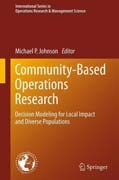
Community-based operations research: decision modeling for local impact and diverse populations
Johnson, Michael P.
Community-based operations research (CBOR) is the use of analytical methods with government and organizations in the formal and informal non-profit sector to improve the lives of individuals and communities. The beneficiaries of these methods tend to be localized, as well as members of disadvantaged and underserved groups. Examples of problems amenable to CBOR include: design of publicinfrastructure such as parks and public art; location of facilities such as homeless shelters or elder care facilities; social interventions such as publichealth initiatives or anti-violence programs, and improved processes such as grants management or human service provision, among many others. Solutions to these problems may be difficult and/or controversial due to conflicting notions of fairness, social impacts or social norms, or because of stigmatized or marginalized populations. CBOR applications address the needs of organizations working for the public good which typically have limited exposure to operationsresearch/management science. Thus, CBOR extends traditional OR/MS practice toallow for ‘solutions’ that consist of identification and formulation of decision problems, linkages between model-based prescriptions and social impacts relevant to providers and policy-makers, and a diversity of solution methods. This domain was first discussed in a chapter in Tutorials in Operations Research2007 - OR Tools and Applications: Glimpses of Future Technologies (INFORMS 2007) by Johnson and Smilowitz and subsequently in an article that appeared in the February 2008 issue of OR/MS Today. Community-based operations research is not primarily a new methodology or theory - its antecedents include community operational research, public-sector operations research and problem structuring methods. Instead, CBOR is a framework for applications of models and methodsto address problems with common characteristics. The relevant analytical tools for CBOR come primarily from the decision sciences; these tools are intendedto help individuals and organizations make better choices regarding strategies to design, services to deliver, facilities to locate, infrastructure to design, and so on. CBOR applications are drawn from disciplines with public-sectorapplications, including public policy, public management, urban and regional planning, housing and community development, urban affairs, human services, public health and gerontology. The research in this book is intended to be normative (defined by stylized models of the real world) and prescriptive (what ought to be done) in nature. However, other research perspectives, defined by descriptive and positive approaches traditionally used in the social sciences areappropriate as well. It is hoped that this book will inspire researchers and practitioners to develop new models and methods, or adapt existing ones, in order that public-focused organizations may better fulfill their missions, and for individuals and communi INDICE: Community-Based Operations Research: Introduction, Theory and Applications. Tutorials in Operations Research 2007: 'Community-Based Operations Research'. Operations Management in Community-Based Nonprofit Organizations. Modeling Equity for Allocating Public Resources. Spatial Optimization and Geographic Uncertainty: Implications for Sex Offender. Locating Neighborhood Parks with a Lexicographic Multiobjective Optimization Method. Using GIS-Based Modelsto Protect Children from Lead Exposure. A Model for Hair Care Flow in Salons in the Black Community. Street Gangs: A Modeling Approach to Evaluating 'At Risk' Youth and Communities. Fair Fare Policies: Pricing Policies that Benefit Transit-Dependent Riders. Decision Making for Emergency Medical Services. Capacity Planning for Publicly Funded Community Based Long-Term Care Services. A DEA Application Measuring Educational Costs and Efficiency of Illinois Elementary Schools.
- ISBN: 978-1-4614-0805-5
- Editorial: Springer New York
- Encuadernacion: Cartoné
- Páginas: 340
- Fecha Publicación: 17/09/2011
- Nº Volúmenes: 1
- Idioma: Inglés
